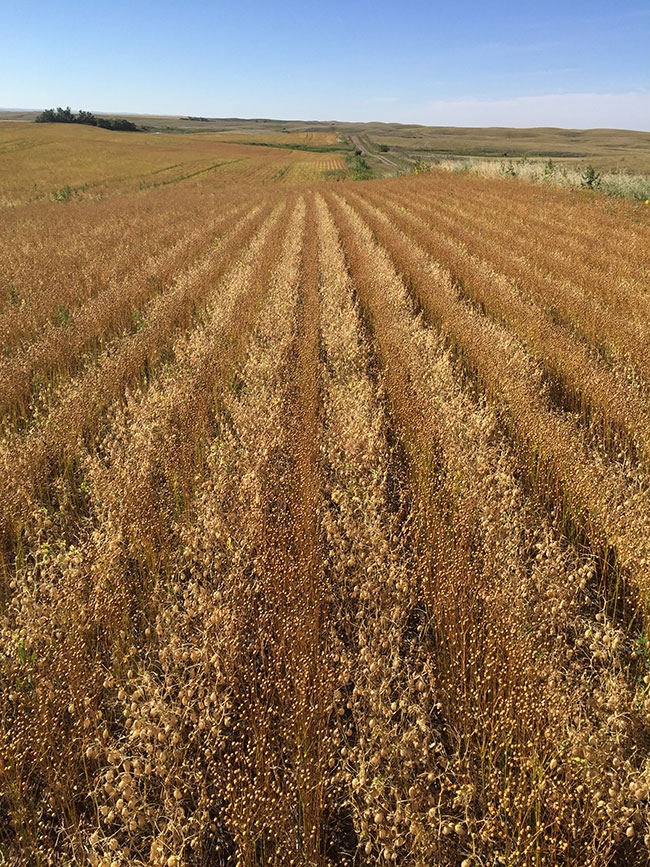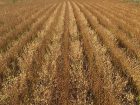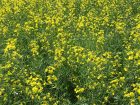
Features
Agronomy
Seeding/Planting
Intercropping trials show promise; research continuing to expand options
A few growers in Saskatchewan are adopting intercropping systems as a way to improve yields and revenue over monocropping. Researchers at the South East Research Farm (SERF) in Redvers, Sask., are helping growers address some of their intercropping questions through small plot research and replicated trials, including demonstrations and evaluations of the potential of various crop combinations.
October 17, 2017 By Donna Fleury
 A flax and chickpea intercrop on Derek Axten’s farm in Minton A few growers in Saskatchewan are adopting intercropping systems
A flax and chickpea intercrop on Derek Axten’s farm in Minton A few growers in Saskatchewan are adopting intercropping systemsThe results so far from research trials and commercial grower field efforts have been positive and interest continues to grow, with estimates of about 20,000 acres of intercrops in the province last year.
SERF research manager Lana Shaw initiated intercropping research projects with flax and chickpeas at Redvers in 2013. The results to date show good, reliable yields of both flax and chickpea have been achieved compared to monocrops, and often the combined yields of flax and chickpea are higher overall than when either crop is grown on its own. The intercrop provides structural support to the chickpea plants and improved harvestability.
Now new trials are underway to help determine the best flax seeding rates and compare mixed versus alternate seeded rows.
“We have expanded the mix of crops and are evaluating different pulses and oilseeds in combination and as monocrops for comparison,” Shaw explains. “In 2016, one trial compared a yellow mustard [Sinapis alba] monocrop with intercrops of yellow pea, maple pea and three types of lentil. A second trial compared a B. carinata monocrop with two types of dry bean, maple pea, fababean and large green lentil. Each crop was grown as a monocrop and then in the various combinations, with a total of 14 different treatments. No fungicide applications were included.”
Some of the plots were seeded with a SeedMaster in mixed rows in the same row, but an inch apart. For example, pulses were put down the fertilizer shank and seeded about 1.5 inches deep, while the oilseeds were put down the seed shank and seeded about three-quarters of an inch deep. In 2016, the mustard trials were seeded with a smaller seeder that placed the seed in the same row and depth. This year, there is a mix of large SeedMaster intercrop trials and small cone seeder trials. Shaw is trying to scale up the trials now that they have shown some promise, since the SeedMaster plots are much larger. The new mustard-pulse intercrop trial seeded this year is a SeedMaster trial.
Monocrop mustard plots were seeded at six pounds per acre (lb/ac) and intercrops were seeded at a half rate or three lb/ac, while pulses were seeded at a three-quarters seeding rate. Shaw explains, “We are trying to get a strong pulse crop and have the mustard in a supporting role. One of the strategies is to try and pick a winner in the intercrop and tailor the fertilizer and seeding rates to favour one crop, with the other crop in more of a supporting role. Sometimes the mix includes a higher value crop and a lower value crop together, so the goal is to end up with more of the higher value crop and targeting agronomics for that crop.”
Results from the 2016 growing season showed the most valuable and high-yielding intercrops were B. carinata with fababean and maple pea, but all intercrops resulted in increased revenue compared to the monocrops. Although the lentil intercrops were less impressive in terms of yield, the total intercrop yield and value with lentil was higher than in the monocrops. The mustard yields were not very high in either the monocrop or the intercrop, however, there is a positive message: mustard is tolerating large amounts of peas or fababeans in the intercrop and performed as well or better than the monocrops. These results suggest there are a large number of potential intercrops that should be evaluated further for productivity and agronomic benefits. Intercrops may reduce risk from excess moisture, including high root and foliar disease pressure in lentil, which was a big problem in the southwest and west central areas of Saskatchewan in 2016. Lentils also have a developing problem with weed control; intercrops would likely lessen the impact of herbicide-resistant weeds and tough perennial weeds.
“These trials have shown positive results in terms of both increased yields and increased revenue and are helping us to prioritize the next research strategies,” Shaw says. “Producers are already trying mustard-pulse intercrops in their fields and they need research results to answer questions on things like seeding rates, variety selection, fertilizer rates, inoculants, disease pressure and weed competition. We are working to continue our research efforts to help growers answer these and other questions.”
This year, Shaw added new trials, including a few unfunded trials alongside other research work, in an effort to help growers find answers. “We seeded fababeans with canola using four different rates of canola and so far the plots are looking very good,” she says. “The seeding timing was a bit of an issue. We ended up seeding fababean-canola intercrop at the same time as the other fababean trials, which was quite early – on May 3 – into quite cold soils. Growers would likely plan to go a few days later than that. Although the timing was early for canola and emergence rates were fair, it was when we could fit the seeding in. Sometimes you have to make some compromises on agronomy to get everything done on time.”
Following up on another suggestion from spring commodity group meetings, Shaw is trialling an intercrop of conventional soybean with flax. Conventional soybean varieties are not often grown because of the lack of a weed control package, however, the markets for those types of soybeans are higher-value ones. The soybean and flax trials include a few different seeding rate combinations and the yield results will be compared after harvest.
One of the challenges with intercropping and harvest planning is trying to match up varieties of the different crops in the mix with similar maturity timing. For example, with a mustard intercrop, it is better to select either a later maturing pea or a lentil variety that typically takes longer to mature. It can be a risk if one of the crops takes longer than expected and the other crop is ripe. Peas, for example, can sit for a while in the field or the crop can be swathed or desiccated at the timing for canola harvest. There is some risk of shattering with canola. Mustard also has some shattering risk, although yellow mustard is less prone. The key is to time the harvest to get as much crop in as possible at the quality targeted. Some crops may require drying if one intercrop has to be taken off a bit early to maximize the other ones.
“Although we are starting to have some reliable research results and there is lots of good advice out there, there is still a lot of trial and error left,” Shaw notes. “Growers still need to go ahead and pick an intercrop that seems reasonable and adjust from experience as they are going. Some growers like the challenge and are not afraid to try and keep working on their system. For others it can be an obstacle, as we don’t yet have specific crop mixes and agronomic practices for particular areas. For now, start small with a 40- or 80-acre field and select crops and varieties recommended for your area and build from there. We need to continue with larger research trials to help assess the opportunities for various intercrops and the best agronomic strategies.”
Shaw also welcomes growers to get together with a few others and contact her to set up a customized tour of the SERF trials.
Increasing system resiliency and diversity
For Derek Axten of Axten Farms in Minton, Sask., intercropping is now a priority across almost 6,000 acres of no-till land, mostly in the dry Brown soil zone. Axten and his wife, Tannis, were recently named the 2017 Outstanding Young Farmers (OYF) for the Saskatchewan
region.
In 2009, Axten ended up with an intercrop by accident after seeding lentils into brown mustard stubble on 640 acres. This resulted in an unintended intercrop – and a good harvest with good yields from both crops. This success started Axten down the road of intercropping, which he has now implemented on most of his farm.
“Our farm is unique, with about two-thirds at our home near Minton in the dry Brown soil zone and the one-third near [the] Milestone/Lang area in the heavy clay Regina plains,” Axten explains. “In 2011, we seeded our first intercrop of peas and canola on a couple of quarters, which worked really well, and we have expanded from there. We have relied on growers like Colin Rosengren, a leader in intercropping since 2004, and researchers like Lana Shaw at SERF to help answer questions and discuss ideas. We have continued with brassica and pulses, and in 2014 added 1,400 acres of flax and chickpea intercrops as well. We have reduced our input use and have not used any fungicides, except for one late season pass last year in 2016 on the Kabuli chickpea fields (compared to three or four passes on neighbouring fields), after one of the wettest seasons on record with almost double the rainfall we usually get [totalling more than 16 inches at Minton]. The chickpeas yielded very well and achieved high seed quality.”
Axten is convinced intercropping works, and for the last two years, he has intercropped all of his broadleaf crops – he sees no reason not to. Climate is a factor. In 2015 it was very dry, but intercrop yields were still 10 to 20 per cent higher than in monocrop fields kept for comparison. In 2016, the growing season was the wettest in recent memory and 2017 has so far been quite dry again, so building resiliency in their farming system is a priority.
“Overall, intercrop yields have never been lower than monocrops and, on average, yields and revenue are higher on the intercrops. Diversity is important and in 2017 [our] intercrops include lentils-flax, mustard-maple peas, sunflowers-hairy vetch, chickpeas-flax, canola-chickling vetch, and canola-winter peas. We will continue to implement intercrops for everything except the cereals, where we have seeded with clover as a companion crop to improve soil and keep cover growing on the land until winter for carbon capture and sunlight harvest.”
All of the crops in Axten’s fields are seeded as mixed rows except flax and chickpea, which are seeded in alternating rows in 20-inch spacing. This helps delay canopy closure and allows for more air movement later into the season. At Minton, the brassica intercrop is typically mustard-lentil because of the drier conditions and weed spectrum, while canola-specialty peas (maple, forage and other high-value pea varieties) are grown at Milestone. The intercrops help the pulses trellis and keep off the ground, improving harvest, yield and crop quality without fertilizer inputs. Seeding rates for brassicas are half the monocrop rates, with canola at 2.4 lb/ac and yellow mustard at five lb/ac, while pulses are seeded at two-thirds the recommended rates. Axten will sometimes seed a full rate of lentils in the mix as the high-value crop.
“I have tried a lot of different varieties and combinations in intercrops and never had a disaster because of maturity differences,” he says. “Although sometimes you may have to wait a bit longer, we’ve always been able to harvest using a combination of straight cutting, swathing and desiccation where required. Some growers are worried about harvest and combine settings, but we haven’t had any real challenges with machinery settings. Initially, separating the two intercrops can be a logistical challenge, but it is no longer a concern. We also found that if both crops are dry in their own right, they will store well together. Last year we stored flax and chickpea well into January until we had time to separate them.”
Intercrops will continue to be a main priority in Axten’s system, with flax and lentils likely taking over more of the brassica-pulse component. Axten is happy to talk to other growers who have questions and encourages those interested to also connect with SERF and tour the plots, or get in touch with other growers, such as Rosengren. The key to success is to do the research upfront. “You can save yourself a lot of pain by spending a half a day with Lana at the SERF plots, which often raises and answers questions you maybe hadn’t thought of ahead of time. There are about eight growers I know of implementing intercrops and we are encouraging more growers to consider intercrops. For our farm, no-till, intercrops, companion crops and cover crops, as well as controlled traffic farming and grazing, have reduced synthetic inputs, increased water retention and built up organic matter. We are seeing improved yields [and] soil improvements and building diversity and resiliency into our farm for the long term.”

